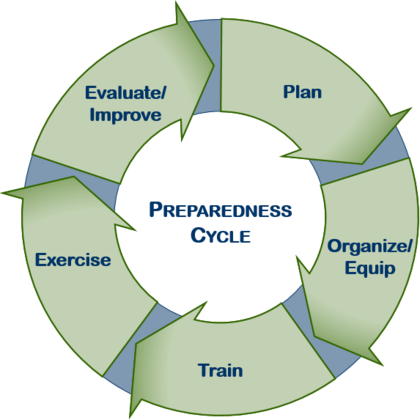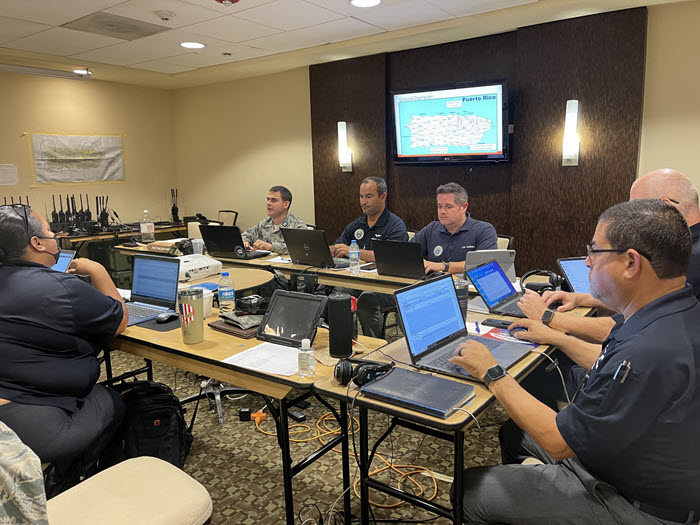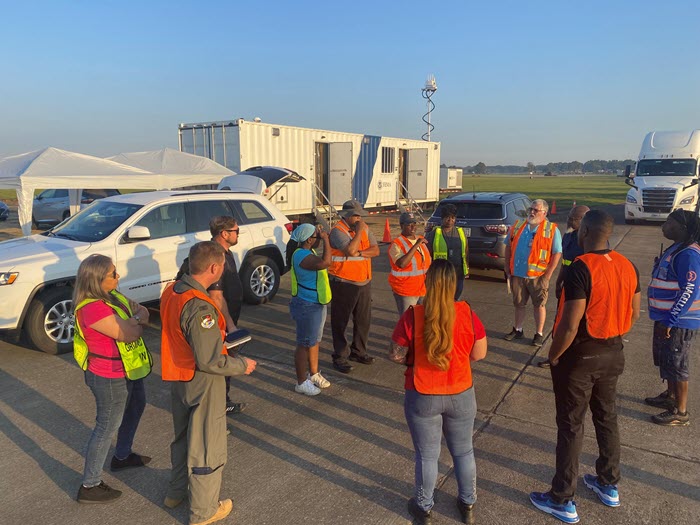Integrated Emergency Management System
When an emergency or disaster occurs:
- agencies from different jurisdictions and government levels need to work together. Major emergencies and disasters ignore city, county, and state boundaries.
- rapid decision making is required.
Without planning and coordination, emergency operations can suffer from serious misdirection and mistakes.
An integrated emergency management system provides a conceptual framework for organizing and managing emergency protection efforts. This framework prescribes when and how local officials and agencies will work together to deal with a full range of emergencies, from natural disasters to terrorism.
Each level of government participates in and contributes to emergency management.
- Local government has direct responsibility for the safety of its citizens, knowledge of the situation and personnel, and proximity to both the event and resources. Emergency Support Services are the departments of local government that are capable of responding to emergencies 24 hours a day. They include law enforcement, fire/rescue, and public works. They may also be referred to as emergency response personnel or first responders.
- State government has legal authorities for emergency response and recovery and serves as the point of contact between local and Federal governments.
- Federal government has legal authorities, fiscal resources, research capabilities, technical information and services, and specialized personnel to assist local and State agencies in responding to and recovering from emergencies or disasters.
The Spectrum of Incident Management Actions
Incident management covers a spectrum of activities ranging from:
- Pre-incident activities, such as information sharing, threat identification, planning, and readiness exercises.
- Incident activities that include lifesaving missions and critical infrastructure support protections.
- Post-incident activities that help people and communities recover and rebuild for a safer future.
The National Planning Frameworks describe how the community works together to achieve the National Preparedness Goal, which is: "A secure and resilient nation with the capabilities required across the whole community to prevent, protect against, mitigate, respond to, and recover from the threats and hazards that pose the greatest risk." These address the full spectrum of emergency management activities, including these five mission areas:
- Prevention: Prevent, avoid or stop an imminent, threatened or actual act of terrorism.
- Protection: Protect our citizens, residents, visitors, and assets against the greatest threats and hazards in a manner that allows our interests, aspirations, and way of life to thrive.
- Mitigation: Reduce the loss of life and property by lessening the impact of future disasters.
- Response: Respond quickly to save lives, protect property and the environment, and meet basic human needs in the aftermath of a catastrophic incident.
- Recovery: Recover through a focus on the timely restoration, strengthening and revitalization of infrastructure, housing and a sustainable economy, as well as the health, social, cultural, historic and environmental fabric of communities affected by a catastrophic incident.
Preparedness as Program Centerpiece
Between emergencies and disasters, emergency managers can focus on preparedness measures. The National Preparedness Cycle is a continuous "cycle of planning, organizing, training, equipping, exercising, evaluating, and taking corrective action" in an effort to ensure effective coordination during incident response (FEMA, "Developing and Maintaining Emergency Operations Plans," 2010).

Threat and hazard identification is a crucial first step in the planning process. This analysis determines:
- what can occur;
- how likely it is to occur;
- what devastation it is likely to cause;
- how likely it is to affect the community;
- how vulnerable the community is to a hazard.
The first step is to develop a list of threats and hazards that may occur in the community. Next, profiles should address each hazard's:
- duration
- seasonal pattern
- speed of onset
The availability of warnings also will play a crucial role in a hazard profile.
Hazard-specific information is combined with a profile of your community to determine the community's vulnerability—or risk of damage—from the hazard.
After information about the community is gathered, emergency managers use it to develop the community's hazard analysis. After a hazard and community profile has been compiled, it is helpful to quantify the community's risk by merging the information so that the community can focus on the hazards that present the highest risk.
Risk is the predicted impact that a threat or hazard would have on people, services, and specific facilities and structures in the community. A severity rating quantifies the expected impact of a specific event.
A guide for conducting threat and hazard identification and risk assessments (THIRA) can be found at: Comprehensive Preparedness Guide 201.
Planning and Coordination

The appearance of U.S. Department of Defense (DoD) visual information does not imply or constitute DoD endorsement.
An Emergency Operations Plan (EOP) is a key component of an emergency program.
When an emergency threatens or strikes, the community must be prepared to take immediate action. An EOP describes:
- what emergency response actions will occur….
- under what circumstances….
- using what resources….
- who will be involved and by what authority.
An EOP consists of the following basic components:
- The Basic Plan
- Annexes
- Appendices
- Standard Operating Procedures
The EOP provides overall authority, roles, and functions during emergencies.
An Emergency Operation Center (EOC) is a central location where agency representatives can coordinate and make decisions when managing an emergency response. EOC personnel do not control the on-scene response but help on-scene personnel by establishing priorities, coordinating the acquisition and assignment of resources, and acting as a liaison with other communities and the State. The EOC is a place for working together.
The Multi-Agency Coordination System (MACS) integrates facilities, equipment, personnel, procedures and communications into a common system with responsibility for coordinating and supporting domestic incident management activities. The functions of the system are to support incident management policies and procedures, facilitate logistical support and resource tracking, inform resource allocation decisions, coordinate incident-related information, and coordinate interagency and intergovernmental issues regarding policies, priorities, and strategies.
The Incident Command System (ICS) defines the operating characteristics, interactive management components, and structure of incident management and emergency response organizations engaged throughout the life cycle of an incident. NIMS requires the use of ICS.
The conclusion of mutual aid agreements to augment local resources is an important part of developing and maintaining an emergency management program.
In any emergency or disaster, mutual aid partners may be able to provide:
- communications capability
- emergency personnel
- overall management strategy and program management
- equipment such as bulldozers or dump trucks
- sandbags
- facilities such as warehouses or temporary shelters
The best way to communicate the plan to response agencies that are responsible for implementing the plan is through training and exercising.
Training is critical to response personnel so that they know:
- what they are to do,
- when they are to do it,
- how they are to do it.

The appearance of U.S. Department of Defense (DoD) visual information does not imply or constitute DoD endorsement.
Functions of an Emergency Management Program
There are two ways to categorize emergency management activities:
- emergency management core functions that are performed during an emergency;
- emergency management program functions that continue on a day-to-day basis.
The eight emergency management core functions performed during emergencies are:
- Direction and Control
- Communications
- Warning
- Emergency Public Information
- Evacuation (or in-place sheltering)
- Mass Care
- Health and Medical Services
- Resource Management
Day-to-day emergency management program functions include:
- Hazard Identification and Risk Assessment
- Hazard Mitigation
- Resource Management
- Planning
- Direction and Control
- Communication and Warning
- Operations and Procedures
- Logistics and Facilities
- Training
- Exercises, Evaluations, and Corrective Actions
- Public Education and Information
- Finance and Administration
Emergency Management Program Partners
Emergency management partners include local, State, and Federal emergency managers.
The State's role is to supplement and facilitate local efforts before, during, and after emergencies. The State must be prepared to maintain or accelerate services and to provide new services to local governments when local capabilities fall short of disaster demands.
The local Emergency Program Manager has the day-to-day responsibility of managing emergency programs and activities. The role entails coordinating all aspects of a jurisdiction's mitigation, preparedness, response, and recovery capabilities.
The State provides direct guidance and assistance to local jurisdictions through program development, and it channels Federal guidance and assistance down to the local level. In a disaster, the State office helps coordinate and integrate resources and apply them to local needs. The State's role might be best described as "pivotal."
The Federal government provides legislation, Executive Orders, and regulations that influence all disaster activities. It also maintains the largest pool of fiscal resources that can be applied to emergency management. Assistance may take the form of fiscal support, technical assistance, and information about materials, personnel resources, and research. FEMA takes a lead role in national preparedness for major crises. It also plays coordinating and supportive/assistance roles for integrated emergency management in partnership with State and local emergency management entities.
Emergency Management Online Training
Click on the following link to access the FEMA's IS-230: Fundamentals of Emergency Management online training. Complete the training and take the online examination. FEMA will provide a certificate, which you are to provide to the instructor as an Adobe Acrobat (.pdf) file.
Deliverable #1 (required - 70 points)
Make sure you save the IS-230 Fundamentals of Emergency Management certificate .pdf file after completing the online certification. To submit your certificate for your grade, return to Canvas and click on the Lesson 7: IS-230 Certificate (GRADED) link. The Assignment will have directions for submitting your certificate.
Please note: Depending on the amount of web traffic, there can be a one to two day delay between the time you complete your IS-230 Certificate and when FEMA emails you the PDF of your certificate. You should consider completing the online training well before the deliverable date.